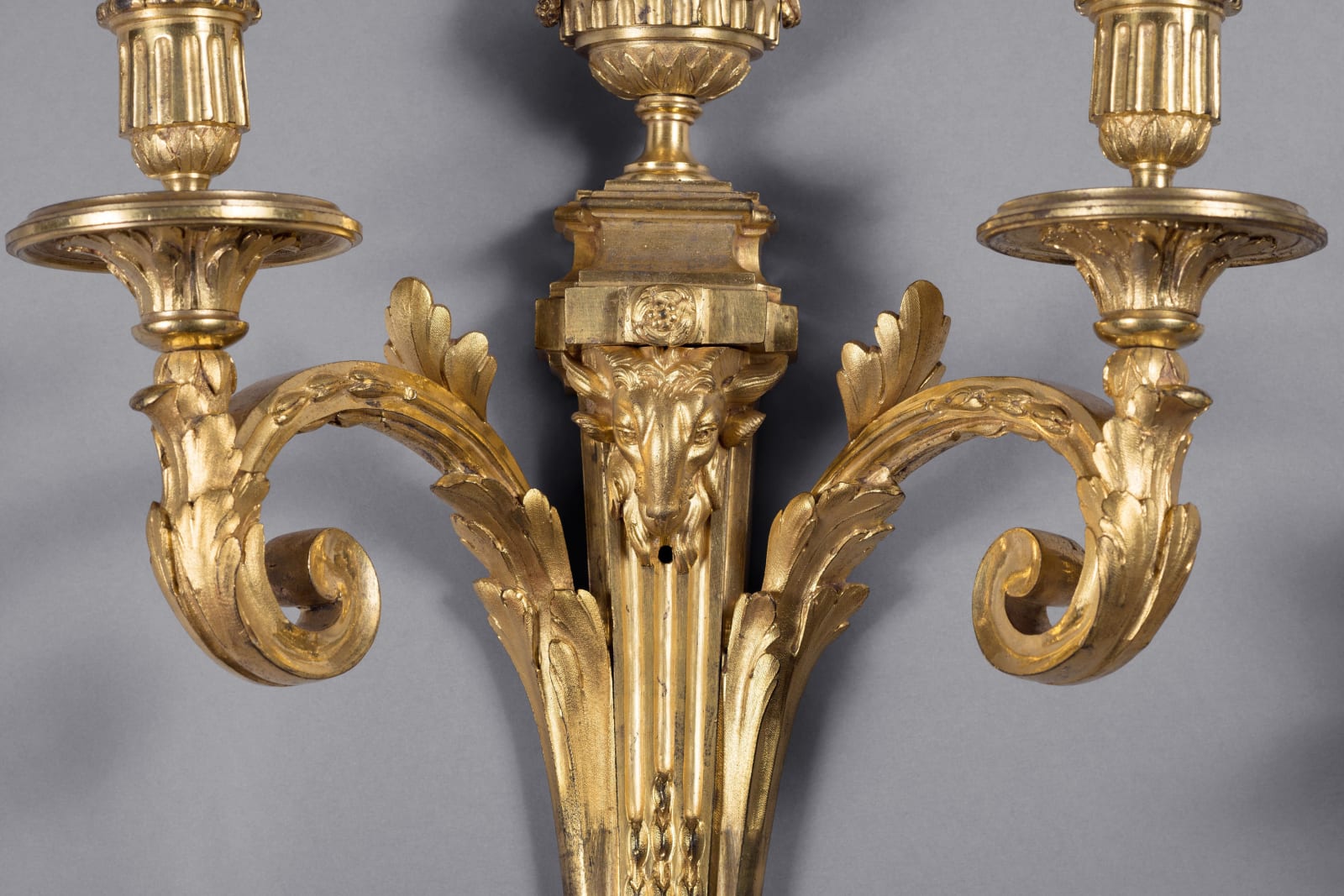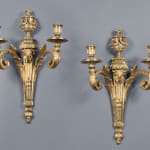Jean-Charles Delafosse (in the style of)
Literature
Hans Ottomeyer and Peter Pröschel, "Vergoldete Bronzen", 1986, p. 186, pl. 3.9.2, illustrating an extremely similar wall-light with three candle branches in the Musée du Louvre, Paris.
An extremely fine pair of Louis XVI gilt bronze two-light wall-lights in the style of Jean-Charles Delafosse, each surmounted by a covered urn with a flaming finial above a gadrooned body hung with foliate swags on a spreading foot, resting on a shaped angular plinth with canted corners above a tapering fluted backplate headed by a bull's head mask, issuing from the backplate are two scrolling foliate-wrapped branches supporting circular drip-pans with foliate undersides and above fluted vase-shaped nozzles, the tapering backplate terminating in a foliate boss
Paris, date circa 1770
The model for these wall-lights, known as à tête de belier, is most commonly associated with the Parisian decorative designer, engraver and architect Jean-Charles Delafosse (1734-89). Pierre Verlet notes that the inventory of the prince de Condé at Palais Bourbon in 1779 includes a pair of wall-lights à tête de bélier with two candle branches that were delivered to him in 1771 by the marchand-mercier Quentin-Claude Pitoin. The same marchand-mercier delivered two other similar pairs in 1775 to Versailles; one was for the chambre de la comtesse de Provence and the other for the chamber de la comtesse d'Artois. Another very similar pair of two-branched wall-lights but with a slightly different surmounting urn and additional swags hanging from the two branches was included in the Rothschild Collection, sold in London 23rdJune 1999, lot 122. Further examples, again with two-lights can be found in the Residenz, Munich while others with three-lights were sold at Rudolph Lepke Berlin, 2nd April 1930 and can also be found in the Musée du Louvre, Paris.
As a Parisian architect, ornamental designer and engraver, Delafosse played an important role in disseminating the 'goût antique'. Although he was apprenticed in 1747 to the sculptor Jean-Baptiste Poullet (d. 1775) he does not seem to have completed his apprenticeship. Rather he concentrated his energies toward becoming a designer and architect. To this effect by 1767 he styled himself 'architecte et professeur pour le dessin'. It was as an innovative and radical designer that Delafosse was his most influential. In 1768 he published the first volume of his most important work, the "Nouvelle Iconologie Historique", containing 110 plates, most of which Delafosse engraved himself. Included were designs for furniture, decorative objects and architectural ornament in the heavy, classicising Louis XVI style.
Up until the mid 1780's Delafosse continued to create numerous designs, predominantly issued through the print seller Chereau, for trophies, cartouches, furniture, vases and light fittings. In all of them Delafosse favoured antique forms, which as here often incorporated vases or urns as well as bold Neo-classical forms with distinct inverted scrolls. Delafosse is known to have designed two houses (1776-83), the Hôtel Titon and the Hôtel Goix both in the rue du Faubourg-Poissonière, Paris. Although they exhibit little structural innovation, their ornamentation reveals characteristic touches such as lions' heads adorning the main entrance of the Hôtel Titon as well as laurel branches above the doors, classical arabesques friezes between the floor levels in the courtyard and two large classical urns in the vestibule. Appointed assistant professor of geometry and perspective at the Académie de Saint-Luc, Delafosse later became a member of the Académie de Bordeaux (1781), where he exhibited a number of his drawings. In 1789 he joined the Garde-National, Paris and subsequently played an active role in the French Revolution.



